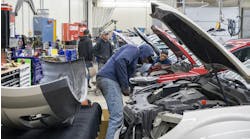The complexity of advanced driver assistance systems (ADAS) has exploded over the past decade. A vehicle in 2010 may have had a basic backup camera, or maybe adaptive cruise control on a luxury model. Compare that to 2025, where even an economy car may have front, rear, and side radars, cameras, and other systems powering a wide array of features.
While great for safety and convenience, ADAS is challenging for aftermarket repairers, particularly when it comes to calibration following a collision. The ADAS knowledge gap often leads to over- or under-repair of ADAS and to friction between insurers, repairers and customers.
ADAS identification software has significant potential to reduce this friction if it offers standardization, conservative identification and concise summaries of service documentation. But the software often just stacks more paperwork on an already thick pile, bringing confusion instead of clarity.
Shops and insurers need ADAS identification that allows them to negotiate from a shared foundation so they can achieve their common goal: getting their mutual customers — drivers — back on the road quickly, in vehicles that have been repaired and calibrated to OEM specs.
ADAS Complexity = Confusion and Friction
The complexity of ADAS is challenging the aftermarket auto repair space and increasing tension between insurers and repair shops. A 2023 AAA report found that ADAS increased collision repair costs by up to 37.6%, driving up insurance premiums. While some body shops may assume all is well if no dashboard warning lights are on and, so, unwittingly overlook ADAS calibration requirements, others may perform unneeded calibrations, and bill insurers accordingly. Since estimates for these calibrations vary widely, it’s also difficult for underwriters to predict repair costs, and adjusters may not have the specialized expertise needed to properly assess these claims. That opacity can lead insurers to pay inflated invoices rather than risk underpaying for a safety-critical procedure.
ADAS identification software — designed to help — often adds to the confusion instead of removing it. These tools generate long reports filled with manufacturer-specific jargon and reference documents that complicate insurance assessments. All parties are looking for efficiency and transparency to speed diagnosis, claims processing, calibration and reimbursement.
ADAS Software that Bridges the Gap
The core issue is a knowledge deficit. More traditional collision repairs like those involving body panels, paint, or suspension are also complex, with huge variations between needs depending on manufacturer, model and year. But over time, the industry has developed a shared understanding of the labor, tools, and parts needed to conduct them. This allows insurers and repairers to quickly reach agreement on the appropriate time and cost for a given repair, without getting bogged down in jargon or minutiae.
Unlike these traditional repairs, ADAS calibrations are a patchwork, with each automaker using different names, procedures and tools — and leaving aftermarket providers to puzzle out the details.
To bridge the knowledge gap, ADAS identification software needs to combine three key features:
Standardized naming: Insurers and shops know what it means to pull a frame, overhaul a bumper, or blend paint. The industry needs the same clarity for ADAS, and simplifying the terminology used across different systems can help. Rather than using manufacturer-specific names, the industry should adopt a unified vocabulary for humans and software alike.
Consider the standardized term “static front camera calibration.” It immediately makes clear that a repair requires a scan tool, calibration target, measuring tape, floor markers, and a target stand. It also requires a repairer to measure the vehicle, place the targets and execute the calibration. Contrast that with more specific names like “EyeSight,” “DrivePilot,” “lane keep assist” and “lane departure warning.” These can all refer to the same system but require more research or specialist knowledge to determine what’s actually required for a repair.
Conservative identification: Software should highlight required calibrations that are high certainty, such as those triggered by a sensor replacement or a major body repair. This minimizes guesswork and ensures essential calibrations are never overlooked. The software should also cite the specific repair actions that triggered the calibration requirement and include relevant documentation for easy reference.
Concise summaries of OEM documents: For calibrations where the requirements are more subtle or ambiguous, professional judgment is key. In these cases, instead of making an arbitrary required/not required decision, software can provide succinct summaries of manufacturer guidelines to allow claims adjusters and shops to negotiate from the same baseline.
For example, some OEM documents require calibration if a body panel repair was performed within 300 mm of a sensor— something that is often difficult to determine based on a repair estimate. Similarly, if a bumper was loosened, but not removed, radar sensor calibration might be required — or not. The best ADAS identification tools won’t make an arbitrary call. Rather, they will flag the case, explain the possible calibration need, and provide clear references to OEM documents to help repair professionals make quicker, more informed decisions.
Why This Matters
When a car is returned to the owner without being returned to its factory state of safety, everyone is at risk — the driver, shop and insurer. But over-repairing isn’t the answer, either, as it just increases costs without necessarily improving safety.
A smart calibration ID solution helps:
Drivers get their cars safely back on the road faster.
Shops avoid missed calibrations, build trust and reduce back-and-forth paperwork.
Insurers understand what’s really needed, so they pay only for legitimate procedures and limit liability.
The Bottom Line
The integration of ADAS has undoubtedly improved safety, but it has also introduced new complexities to the repair and insurance sectors. ADAS identification software is a powerful tool for navigating these complexities, helping ensure more efficient, lower-cost and transparent repair processes. With standardized names, conservative recommendations and concise documentation, this software can help insurers and collision repair professionals speak the same language — helping speed and streamline repairs and claims processing, while increasing transparency and driver safety.




